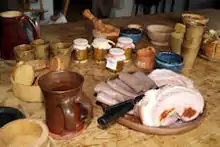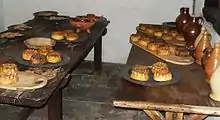Tudor food and drink
Tudor food is the food consumed during the Tudor period of English history (1485–1603).
Food
Vegetables
The common vegetables used in the Tudor period were onions and cabbages, but nearer the end of the Tudor period, new foods were brought over from the Americas, such as tomatoes, potatoes, and peppers.
Meat
The poor ate whatever meat they could find, such as rabbits, blackbirds, pheasants, partridges, hens, ducks, and pigeons, and also fish they caught from lakes and rivers. Meanwhile, the rich people also ate more costly varieties of meat, such as swan, peafowl, geese, boar, and deer (venison).[1]
Herbs
Herbs were often used by rich Tudors to flavour their meals and they had a separate herb garden to grow what they needed, such as parsley, mint, rosemary, thyme and sage.[1]
Bread
Tudors of all classes consumed bread in all of their meals as the main source of carbohydrates; however, its quality varied. The cheapest bread available was Carter's bread which was a mixture of rye and wheat. The middle class or prosperous tenants ate ravel—also known as yeoman's bread—made of wholemeal. The most expensive bread was manchet, made of white wheat flour.[2]
Banquets and feasts
The aristocrats held banquets and feasts consisting of different courses where each course had a variety of dishes brought out at the same time. People then could choose what they want to eat.[3]
First course


- Brawn (Boar Meat)
- Roast Tongue
- Leg of Pork
- Roast Beef
- Roast Venison (deer)
- Meat Pie
- Vegetables in season
- Bread
- Wine
Second course
- Roast Lamb
- Rabbit
- Bread
- Preserved fruit
- Gingerbread
- Sugared almonds
- Deer pie
- Fish Pie
Beverages
Everyone drank ale during the Tudor period because water was considered unhealthy. Ale at the time was brewed without hops and was not particularly alcoholic.[2] The rich also drank wine,[1] which was mostly brought from Europe, but some of them were produced in the vineyards in Southern England.
The rich drank from Wine glasses imported from Italy which were incredibly expensive while the poor drank from wooden goblets and cups.[1]
Table manners
Having clean hands at the time was very important due to several or more people digging into a common dish with their fingers. Therefore, they were advised by "Miss Manners" of the day to wash their hands out in the open where everyone could see to make sure that they were clean.[4] Besides that, manuals for manners from the Renaissance and Middle Ages listed some things that are frowned upon at the dinner table, including:
- Putting fingers in the ears.
- Putting hands on the heads.
- Blowing nose with the hands.
- Men were told to refrain from scratching.
- Blowing noses off or wiping off sweat with napkins.
- Poking around on a plate, probably looking for the better piece of food.
- Throwing bones on the floor. The proper place for bones was a platter.
- The release of wind.
References
- "Tudor Food and Drink: Facts and Information | Primary Facts". primaryfacts.com. Retrieved 2016-03-16.
- "Tudor England Food & Drink Facts - What Did Tudors Eat?". English History. Retrieved 2016-03-16.
- "The Medieval Menu". tudorhistory.org. Retrieved 2016-03-16.
- "Table manners". tudorhistory.org. Retrieved 2016-03-16.
Further reading
| Wikimedia Commons has media related to The Tudor Kitchens at Hampton Court Palace. |
- Alison Sim (1997) Food and Feast in Tudor England. Stroud: Sutton
- Peter Brears (2003) Tudor Cookery: recipes & history; revised. Swindon: English Heritage
